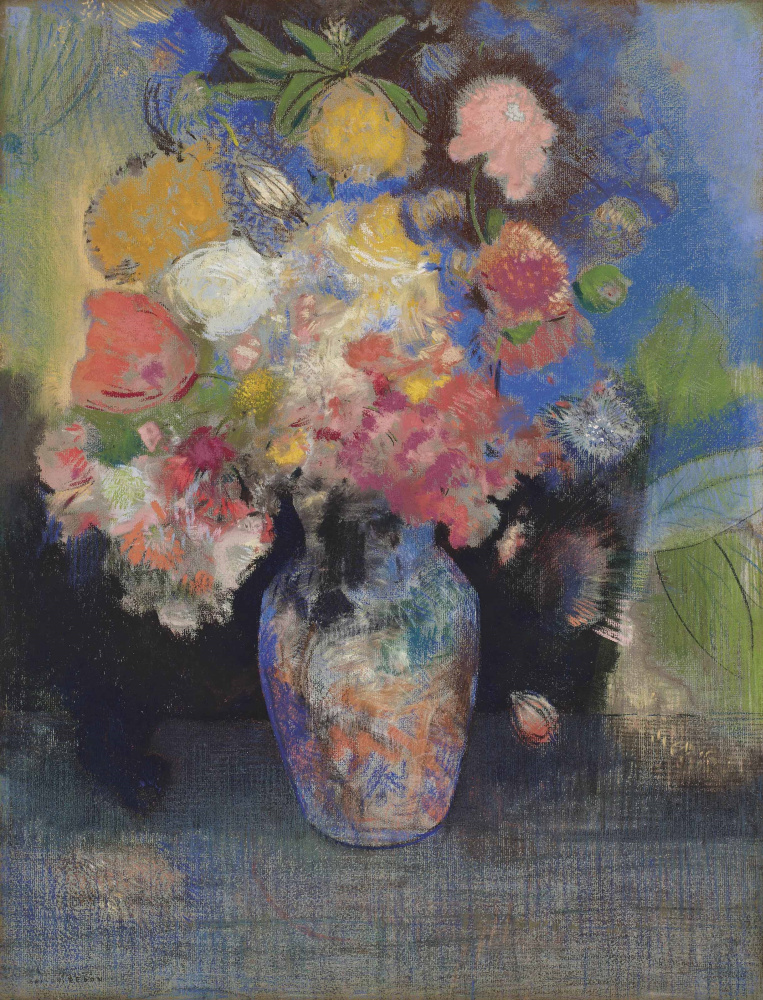log in
Enter site
Login to use Arthive functionality to the maximum
Flowers
Odilon Redon • Painting, 61.9×47.6 cm
Description of the artwork «Flowers»
The mature artist Redon flowers are like real ones. They stand in vases and consist of obvious parts: stems, stalks and leaves. They are naively natural, carelessly harmonious in bouquets. Only with a careful and long scrutiny of the floral still lifes Redona becomes a bit uncomfortable. Some touchingly impressionable researchers even claim that the floral still lifes of the 60-year-old Redon are crazier and more terrible than his monsters and monsters painted by charcoal in his youth. But on the part of critics this, of course, is not a real spectator's fright, but a professional way to draw attention to Redon's bouquets, to explain their nonrandomness in the visionary, dreamy, imaginative world of the artist.
In his youth, Redon painted charcoal and printed in one color his famous noir: on thin stems among the marshes grew sad human heads, in the illustrations for Baudelaire's Flowers of Evil, concentrated young faces-buds swayed on thin stems over a bowl, similar to ritual. In the mature "colored" works of Redon, most often made by pastel, the flowers grow from nowhere: they blossom in the skies above their heads Buddhas, braid Ophelia, in cosmic zero gravity or in laboratory sterility soar colored spots, broken up into stamens and seeds. Unidentified galaxies, unattributed worlds, concealing a special internal rhythm and inertia of the emerging life.
It is clear that the flowers of Redon are living and complex organisms.
In the 1900s he painted floral still lifes primarily because they sell well. Bouquets in vases: sometimes they can recognize chamomile and poppies, nasturtiums and cornflowers. Sometimes flowers are invented: unearthly, nonexistent, inaccessible for identification by botanical atlases. But in carrying out commercially demanded still-lifes, Redon does not in the least betray himself in favor of an obvious advantage. Redon remains Redon.
French critics George Athena and Aime Merlot, who wrote under the pseudonym Marius-Are Leblon, published in 1907 in the journal Revue illustrée the first article-justification for the colors of Redon. The artist, which until now has been very little mentioned in the press, was delighted with the article and said that he felt finally alive and rewarded for the changes. Theblocks wrote: "Amazed by the shades of this flower to awe, admiring his form with all the depths of naivety, he was soon overshadowed by the discovery of the greatest mystery of nature, and from that very moment dissolved into this utter clarity, filling all the secluded corners of his imagination. He wrote flowers exactly as we know them: a geranium among the velor leaves, daisies, fluttering thickets of acacia, orange yellowfin and nasturtium - miraculously they are before our eyes, breaking through space with their thin stems with dazzling coronals, and the sparkling of their color shades suspends the time run. Looking at them, and we make our way through the shadow".
Redon remained an artist who seeks the supernatural, the invisible. But inevitably accumulating the experience of observing nature, discovers that you do not need to invent anymore. There is nothing more mystical than nature itself.
Author: Anna Sidelnikova
In his youth, Redon painted charcoal and printed in one color his famous noir: on thin stems among the marshes grew sad human heads, in the illustrations for Baudelaire's Flowers of Evil, concentrated young faces-buds swayed on thin stems over a bowl, similar to ritual. In the mature "colored" works of Redon, most often made by pastel, the flowers grow from nowhere: they blossom in the skies above their heads Buddhas, braid Ophelia, in cosmic zero gravity or in laboratory sterility soar colored spots, broken up into stamens and seeds. Unidentified galaxies, unattributed worlds, concealing a special internal rhythm and inertia of the emerging life.
It is clear that the flowers of Redon are living and complex organisms.
In the 1900s he painted floral still lifes primarily because they sell well. Bouquets in vases: sometimes they can recognize chamomile and poppies, nasturtiums and cornflowers. Sometimes flowers are invented: unearthly, nonexistent, inaccessible for identification by botanical atlases. But in carrying out commercially demanded still-lifes, Redon does not in the least betray himself in favor of an obvious advantage. Redon remains Redon.
French critics George Athena and Aime Merlot, who wrote under the pseudonym Marius-Are Leblon, published in 1907 in the journal Revue illustrée the first article-justification for the colors of Redon. The artist, which until now has been very little mentioned in the press, was delighted with the article and said that he felt finally alive and rewarded for the changes. Theblocks wrote: "Amazed by the shades of this flower to awe, admiring his form with all the depths of naivety, he was soon overshadowed by the discovery of the greatest mystery of nature, and from that very moment dissolved into this utter clarity, filling all the secluded corners of his imagination. He wrote flowers exactly as we know them: a geranium among the velor leaves, daisies, fluttering thickets of acacia, orange yellowfin and nasturtium - miraculously they are before our eyes, breaking through space with their thin stems with dazzling coronals, and the sparkling of their color shades suspends the time run. Looking at them, and we make our way through the shadow".
Redon remained an artist who seeks the supernatural, the invisible. But inevitably accumulating the experience of observing nature, discovers that you do not need to invent anymore. There is nothing more mystical than nature itself.
Author: Anna Sidelnikova


